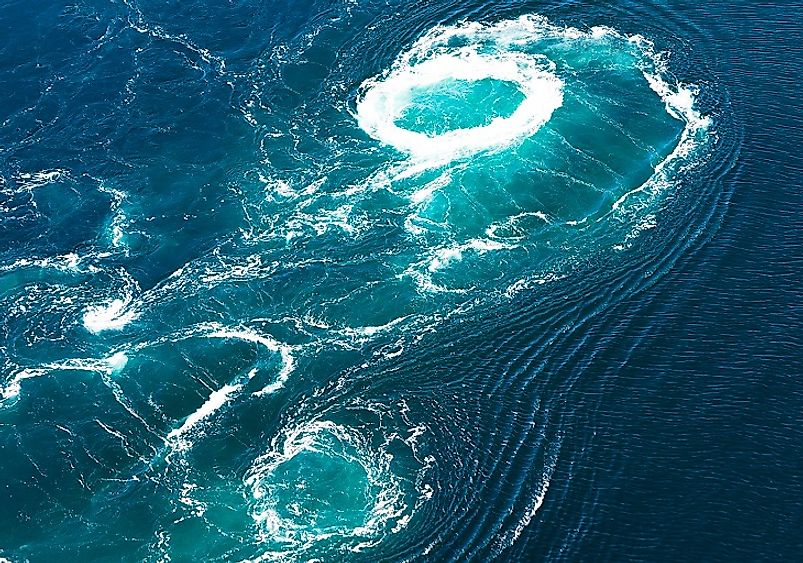Whirlpools And Maelstroms

Description
Whirlpools and maelstroms have for long fascinated the human imagination and has often produced exaggerated descriptions of these dangerous pools of swirling waters engulfing large ships into their deadly funnel. However, though this is not quite true, there is no denying that spots in the ocean with maelstroms and whirlpools can indeed suck in small vessels and unfortunate mariners who happen to fall into these dangerous waters. There is not much difference between whirlpools and maelstroms, only the the latter refers to a much larger form of the former, usually occurring in the oceans and seas of the world. Whirlpools and maelstroms are caused when opposing currents meet or when strong winds blowing over the surface of water alter the direction of currents. The presence of undulating geographical features on seabed might also result in such water vortexes.
Notable Whirlpools and Maelstorms
The Saltstraumen strait, located near the Arctic Circle in Bodø, in the Norwegian county of Nordland, has the strongest maelstrom in the world. About 400 million cubic meters of water funnels through the narrow strait each day, resulting in highly turbulent waters and a giant maelstrom. Ships are allowed to pass through this strait only in specific periods of the day when the currents are less dangerous in nature. Tourists often visit the area to observe the violent maelstrom and wonder at its strength. Another dangerous stretch of water with furious eddies and whirlpools occurs in the Norwegian Sea near the Lofoten archipelago of Norway. Known as the Moskstraumen, this system of whirlpools and eddies are believed to have resulted from strong tides in the region as well as the unique features of the seabed in the region with shallow ridges between the islands of the archipelago. Another area of the world with lethal maelstroms involves the waters of the Corryvreckan strait to the north of the Gulf of Scotland in Scotland. Here strong tides and huge volumes of water flowing into the strait are responsible for creating massive waves, maelstroms and an overall turbulent water flow. Whirlpools are also known to form at the base of waterfalls. Whirlpools at the base of the Niagara Falls in North America, are also known for their perilous nature.
Manmade Whirlpools
Though whirlpools and maelstroms are primarily a work of nature, the intrusion of man has often led to the development of whirlpools in areas with no such symptoms, at times followed by disastrous consequences. A drilling mishap in 1980 created a temporary giant whirlpool on Lake Peigneur in Louisiana in the U.S.A., an event that transformed the 3-feet deep lake into a 1,300 feet deep one, and resulted in the loss of large parts of a botanical garden, 10% of the land area of Jefferson Island, and other losses during the disaster. In June of 2015, a man-made whirlpool formed at Lake Texoma bordering the U.S. States of Texas and Oklahoma. The whirlpool formed near the dam that creates the lake.
Whirlpools and Climate Change
Recent research reports suggest that whirlpools and maelstroms in the oceans influence the climate over land. As is already known, dissipation and transfer of heat by water currents have an important role to play in determining the temperatures on land. Similarly, giant whirlpools and maelstroms, carrying huge volumes of water and transmitting heat across oceans, also might be responsible for changes in weather patterns in different parts of the world where they are found.
Dangers of Whirlpools and Maelstroms in Fiction and in Reality
Many notable authors have mentioned gigantic whirlpools and maelstroms that have swallowed everything that came their way. For example, such oceanic swirls have been described in the "A Descent into the Maelström” by Edgar Allan Poe, “20,000 Leagues Under the Sea” by Jules Verne, and “Moby Dick” by Herman Melville. However, though in reality, the whirlpools and maelstroms are not as perilous as described in these novels, they are still known to be dangerous to small sea-faring vessels as they are powerful enough to trigger wrecks and sink small boats. In 2000, a whirlpool in the French Pass drowned a number of student divers in the sea. In the Corryvreckan whirlpool near Scotland, a team of professionals shooting a documentary on the whirlpool, threw a mannequin, fitted with a life jacket and depth gauge, into the swirling waters of the strait. The life jacket was of no use in the waters and the mannequin was immediately sucked into the depths of whirlpool and then washed up downstream. After observing the depth gauge tied to the mannequin, it was estimated that it had been sucked into depths of about 860 feet before washing up downstream.







